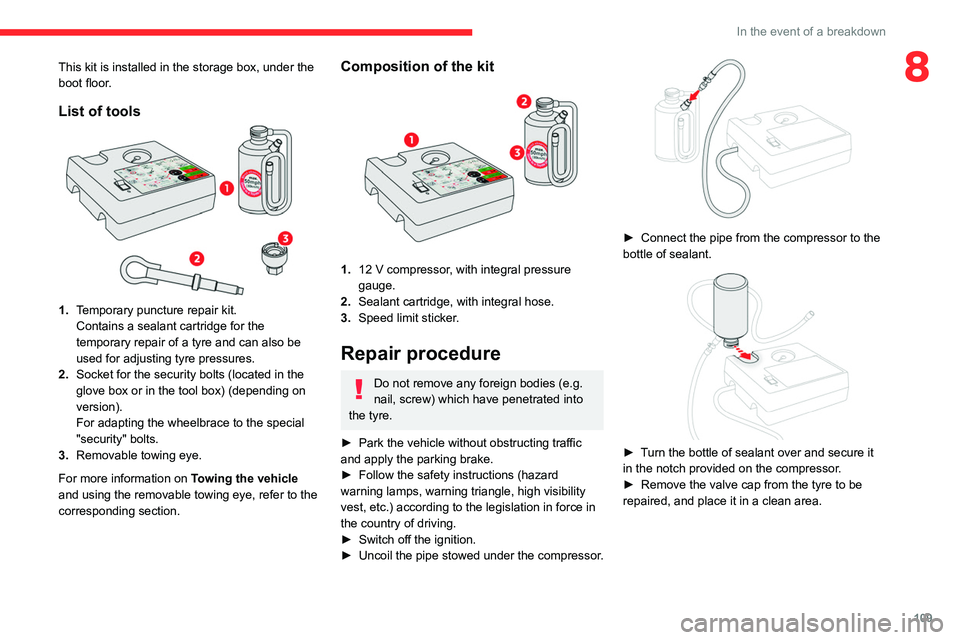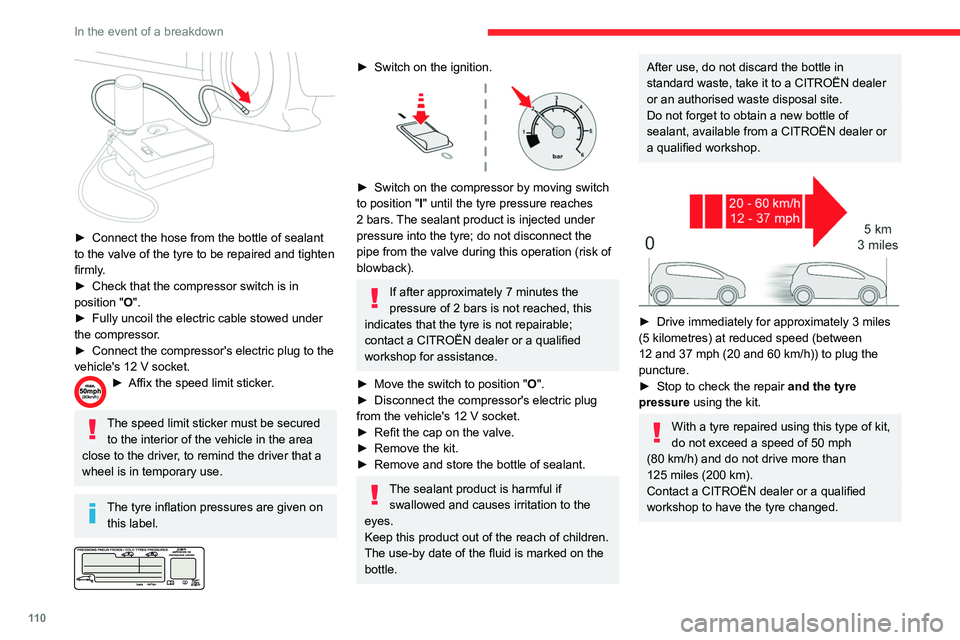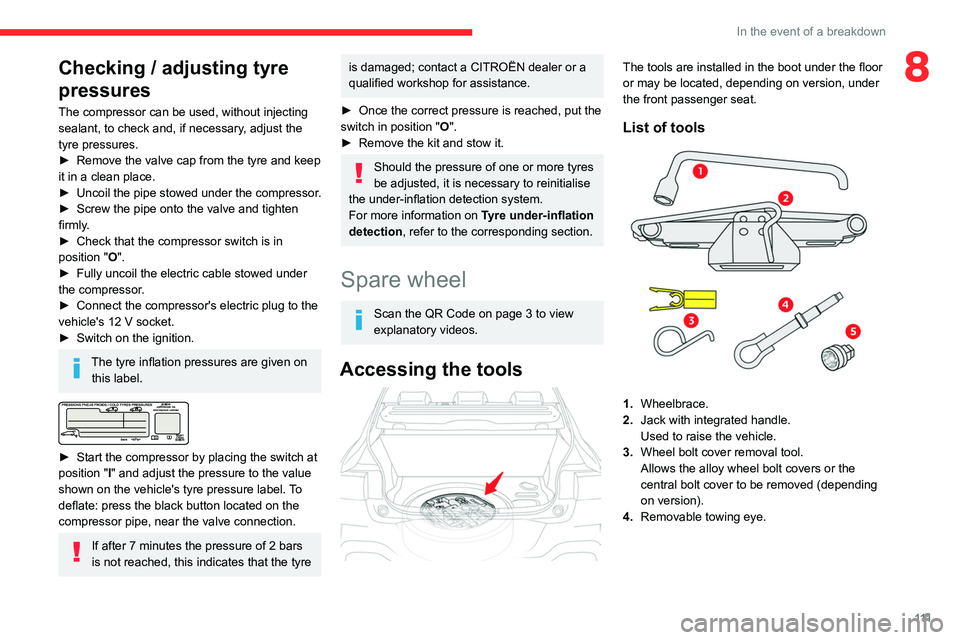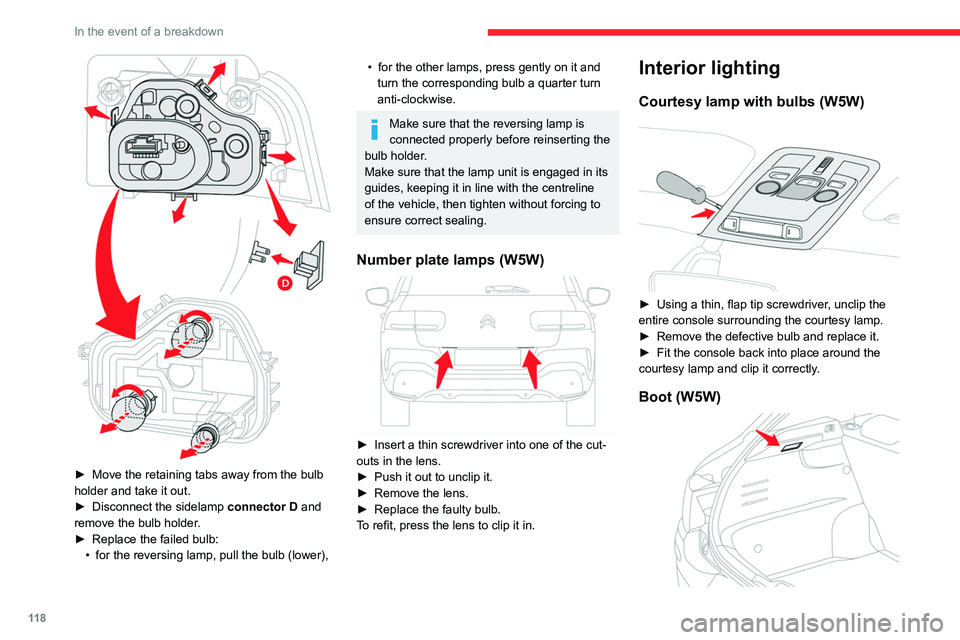CITROEN C4 CACTUS 2023 Owners Manual
Manufacturer: CITROEN, Model Year: 2023, Model line: C4 CACTUS, Model: CITROEN C4 CACTUS 2023Pages: 196, PDF Size: 6.12 MB
Page 111 of 196

109
In the event of a breakdown
8This kit is installed in the storage box, under the
boot floor.
List of tools
1.Temporary puncture repair kit.
Contains a sealant cartridge for the
temporary repair of a tyre and can also be
used for adjusting tyre pressures.
2. Socket for the security bolts (located in the
glove box or in the tool box) (depending on
version).
For adapting the wheelbrace to the special
"security" bolts.
3. Removable towing eye.
For more information on Towing the vehicle
and using the removable towing eye, refer to the
corresponding section.
Composition of the kit
1. 12 V compressor, with integral pressure
gauge.
2. Sealant cartridge, with integral hose.
3. Speed limit sticker.
Repair procedure
Do not remove any foreign bodies (e.g.
nail, screw) which have penetrated into
the tyre.
►
Park the vehicle without obstructing traffic
and apply the parking brake.
►
Follow the safety instructions (hazard
warning lamps, warning triangle, high visibility
vest, etc.) according to the legislation in force in
the country of driving.
►
Switch off the ignition.
►
Uncoil
the pipe stowed under the compressor.
► Connect the pipe from the compressor to the
bottle of sealant.
► Turn the bottle of sealant over and secure it
in the notch provided on the compressor.
►
Remove the valve cap from the tyre to be
repaired, and place it in a clean area.
Page 112 of 196

11 0
In the event of a breakdown
► Connect the hose from the bottle of sealant
to the valve of the tyre to be repaired and tighten
firmly
.
►
Check that the compressor switch is in
position
"O".
►
Fully uncoil the electric cable stowed under
the compressor
.
►
Connect the compressor's electric plug to the
vehicle's 12
V socket.
► Affix the speed limit sticker .
The speed limit sticker must be secured
to the interior of the vehicle in the area
close to the driver, to remind the driver that a
wheel is in temporary use.
The tyre inflation pressures are given on this label.
► Switch on the ignition.
► Switch on the compressor by moving switch
to position " I" until the tyre pressure reaches
2 bars. The sealant product is injected under
pressure into the tyre; do not disconnect the
pipe from the valve during this operation (risk of
blowback).
If after approximately 7 minutes the
pressure of 2 bars is not reached, this
indicates that the tyre is not repairable;
contact a CITROËN dealer or a qualified
workshop for assistance.
►
Move the switch to position " O
".
►
Disconnect the compressor's electric plug
from the vehicle's 12
V socket.
►
Refit the cap on the valve.
►
Remove the kit.
►
Remove and store the bottle of sealant.
The sealant product is harmful if swallowed and causes irritation to the
eyes.
Keep this product out of the reach of children.
The use-by date of the fluid is marked on the
bottle.
After use, do not discard the bottle in
standard waste, take it to a CITROËN dealer
or an authorised waste disposal site.
Do not forget to obtain a new bottle of
sealant, available from a CITROËN dealer or
a qualified workshop.
► Drive immediately for approximately 3 miles
(5 kilometres) at reduced speed (between
12 and 37 mph (20 and 60
km/h)) to plug the
puncture.
►
Stop to check the repair
and the tyre
pressure using the kit.
With a tyre repaired using this type of kit,
do not exceed a speed of 50
mph
(80
km/h) and do not drive more than
125
miles (200 km).
Contact a CITROËN dealer or a qualified
workshop to have the tyre changed.
Checking / adjusting tyre
pressures
The compressor can be used, without injecting
sealant, to check and, if necessary, adjust the
tyre pressures.
► Remove the valve cap from the tyre and keep
it in a clean place.
► Uncoil the pipe stowed under the compressor.
► Screw the pipe onto the valve and tighten
firmly.
► Check that the compressor switch is in
position " O".
► Fully uncoil the electric cable stowed under
the compressor.
► Connect the compressor's electric plug to the
vehicle's 12 V socket.
► Switch on the ignition.
The tyre inflation pressures are given on
this label.
► Start the compressor by placing the switch at
position " I" and adjust the pressure to the value
shown on the vehicle's tyre pressure label. To
deflate: press the black button located on the
compressor pipe, near the valve connection.
If after 7 minutes the pressure of 2 bars
is not reached, this indicates that the tyre
Page 113 of 196

111
In the event of a breakdown
8Checking / adjusting tyre
pressures
The compressor can be used, without injecting
sealant, to check and, if necessary, adjust the
tyre pressures.
►
Remove the valve cap from the tyre and keep
it in a clean place.
►
Uncoil
the pipe stowed under the compressor.
►
Screw the pipe onto the valve and tighten
firmly
.
►
Check that the compressor switch is in
position " O
".
►
Fully uncoil the electric cable stowed under
the compressor
.
►
Connect the compressor's electric plug to the
vehicle's 12
V socket.
►
Switch on the ignition.
The tyre inflation pressures are given on this label.
► Start the compressor by placing the switch at
position " I
" and adjust the pressure to the value
shown on the vehicle's tyre pressure label. To
deflate: press the black button located on the
compressor pipe, near the valve connection.
If after 7 minutes the pressure of 2 bars
is not reached, this indicates that the tyre
is damaged; contact a CITROËN dealer or a
qualified workshop for assistance.
►
Once the correct pressure is reached, put the
switch in position " O
".
►
Remove the kit and stow it.
Should the pressure of one or more tyres
be adjusted, it is necessary to reinitialise
the under-inflation detection system.
For more information on Tyre under-inflation
detection, refer to the corresponding section.
Spare wheel
Scan the QR Code on page 3 to view
explanatory videos.
Accessing the tools
The tools are installed in the boot under the floor
or may be located, depending on version, under
the front passenger seat.
List of tools
1. Wheelbrace.
2. Jack with integrated handle.
Used to raise the vehicle.
3. Wheel bolt cover removal tool.
Allows the alloy wheel bolt covers or the
central bolt cover to be removed (depending
on version).
4. Removable towing eye.
Page 114 of 196

11 2
In the event of a breakdown
5.Socket for the security bolts (located in the
glove box or in the tool box) (depending on
version).
For adapting the wheelbrace to the special
"security" bolts.
For more information on Towing, please refer to
the corresponding section.
These tools are specific to the vehicle and may vary according to the level of
equipment.
Do not use them for any other purpose.
The jack must only be used to change a wheel with a damaged or punctured tyre.
Do not use any jack other than the one
supplied with the vehicle.
If the vehicle does not have its original jack,
contact a CITROËN dealer or a qualified
workshop to obtain the one that was intended
by the manufacturer.
The jack meets European standards, as
defined in the Machinery Directive 2006/42/
CE.
The jack does not require any maintenance.
Access to the spare wheel
The spare wheel is installed in the boot, under
the floor.
Depending on engine, the spare wheel is a
standard wheel or the space-saver type.
Taking out the wheel
► Unclip and take out the tool storage box.
► Unscrew the central nut.
►
Remove the fixing parts (nut and bolt).
► Raise the spare wheel towards the back of
the boot.
►
T
ake the wheel out of the boot.
Putting the spare wheel back in place
► Put the spare wheel back in place in its
housing.
►
Slacken the nut on the bolt by a few turns.
►
Position the fastening device (nut and bolt) in
the middle of the wheel.
►
T
ighten the central nut sufficiently to retain
the wheel correctly.
►
Depending on version, put the tool box back
in place
in the middle of the wheel and clip it in
place.
If there is no wheel in the well, the
fastening device (nut and bolt) cannot be
refitted.
Removing a wheel
Parking the vehicle
Immobilise the vehicle where it does not
block traffic: the ground must be level, stable
and non-slippery.
With a manual gearbox, engage first gear
then switch off the ignition to block the
wheels.
With an automatic gearbox, place the gear
selector in position P then switch off the
ignition to block the wheels.
Apply the parking brake and check that the
warning lamp is on in the instrument panel.
The occupants must get out of the vehicle
and wait where they are safe.
Never go underneath a vehicle raised using a
jack; use an axle stand.
Wheel with wheel trim
When refitting the wheel, refit the wheel
trim, starting by placing its aperture in line
with the valve and then pushing it into place
all round its edge with the palm of your hand.
Page 115 of 196

11 3
In the event of a breakdown
8Removing a wheel
Parking the vehicle
Immobilise the vehicle where it does not
block traffic: the ground must be level, stable
and non-slippery.
With a manual gearbox, engage first gear
then switch off the ignition to block the
wheels.
With an automatic gearbox, place the gear
selector in position
P
then switch off the
ignition to block the wheels.
Apply the parking brake and check that the
warning lamp is on in the instrument panel.
The occupants must get out of the vehicle
and wait where they are safe.
Never go underneath a vehicle raised using a
jack; use an axle stand.
Wheel with wheel trim
When refitting the wheel, refit the wheel
trim, starting by placing its aperture in line
with the valve and then pushing it into place
all round its edge with the palm of your hand.
List of operations
► If the vehicle has steel wheels, remove the
wheel trim.
►
If the vehicle has alloy wheels, remove the
bolt cover(s) using tool 3
.
►
If the vehicle is equipped with it, fit security
bolt socket
5 to wheelbrace 1 to slacken the
security bolt.
►
Slacken the other bolts using the
wheelbrace
1
only.
► Place the foot of jack 2 on the ground and
ensure that it is directly below the front A or
rear
B jacking point on the underbody, whichever
is closest to the wheel to be changed.
► Extend the jack 2 until its head comes into
contact with the jacking point A or B, whichever
is used; the contact area A or B on the vehicle
must be correctly inserted into the central part of
the head of the jack.
►
Raise the vehicle until there is sufficient
space between the wheel and the ground to
admit the spare (not punctured) wheel easily
.
Page 116 of 196

11 4
In the event of a breakdown
Ensure that the jack is stable. If the
ground is slippery or loose, the jack may
slip or collapse - risk of injury!
Take care to position the jack strictly at
one of the jacking points
A
or B under the
vehicle, ensuring that the head of the jack is
centred under the contact area of the vehicle.
Otherwise, there is a risk of damage to the
vehicle and/or of the jack collapsing - risk of
injury!
► Remove the bolts and store them in a clean
place.
►
Remove the wheel.
Fitting a wheel
Fitting a steel or "space-saver" type
spare wheel
If the vehicle is equipped with alloy wheels,
the washers do not make contact with the
steel or "space-saver" type spare wheel. The
wheel is secured by the conical contact of
each bolt.
List of operations
► Put the wheel in place on the hub.
► Screw in the bolts fully by hand.
►
If your vehicle is so equipped, pre-tighten the
security bolt using the wheelbrace 1
fitted with
the security socket 5.
►
Pre-tighten the other bolts using the
wheelbrace 1
only.
► Lower the vehicle again fully .
► Fold jack 2 and detach it.
► If your vehicle is so equipped, tighten the
security bolt using the wheelbrace 1
fitted with
the security socket 5.
►
T
ighten the other bolts using the wheelbrace
1 only.
►
Stow the tools in their box.
After changing a wheel
Store the punctured wheel in the boot or,
depending on version, remove the central cover
first to store it beneath the floor in place of the
spare wheel.
With a "space-saver" type spare wheel
Deactivate certain driving aid functions
(Active Safety Brake, etc.).
Do not exceed the maximum authorised
speed of 50 mph (80 km/h).
Driving with more than one “space-saver”
type spare wheel is prohibited.
Visit a CITROËN dealer or a qualified
workshop as soon as possible to have
the tightness of the bolts and the pressure of
the spare wheel checked.
Have the punctured tyre examined. After
inspection, the technician will advise you on
whether the tyre can be repaired or if it must
be replaced.
Page 117 of 196

11 5
In the event of a breakdown
8After changing a wheel
Store the punctured wheel in the boot or,
depending on version, remove the central cover
first to store it beneath the floor in place of the
spare wheel.
With a "space-saver" type spare wheel
Deactivate certain driving aid functions
(Active Safety Brake, etc.).
Do not exceed the maximum authorised
speed of 50 mph (80
km/h).
Driving with more than one “space-saver”
type spare wheel is prohibited.
Visit a CITROËN dealer or a qualified
workshop as soon as possible to have
the tightness of the bolts and the pressure of
the spare wheel checked.
Have the punctured tyre examined. After
inspection, the technician will advise you on
whether the tyre can be repaired or if it must
be replaced.
Changing a bulb
In some weather conditions (e.g. low
temperature or humidity), misting on the
internal surface of the glass of the headlamps
and rear lamps is normal, and will disappear
after the lamps have been on for a few
minutes.
The headlamps have polycarbonate lenses with a protective coating:
–
Do not clean them with a dry or abrasive
cloth, nor with detergent or solvent
products.
–
Use a sponge and soapy water or a pH
neutral product.
–
When using a high-pressure washer on
persistent marks, do not keep the lance
directed towards the headlamps, lamps or
their edges for too long, so as not to damage
their protective coating and seals.
Changing a bulb must only be done with
the ignition off and after the headlamp /
lamp has been switched off for several
minutes - risk of serious burns!
Do not touch the bulb directly with your
fingers; use a lint-free cloth.
It is essential only to use anti-ultraviolet
(UV) type bulbs, so as not to damage the
headlamp.
Always replace a failed bulb with a new bulb
of the same type and specification. To avoid
lighting imbalance, replace the bulbs in pairs.
Opening the bonnet / Accessing the
bulbs
With the engine warm, proceed with caution -
risk of burns!
Take care with objects or clothing that could
be caught in the blades of the cooling fan -
risk of strangulation!
Halogen bulbs (Hx)
To ensure good quality lighting, check
that the bulb is correctly positioned in its
housing.
After changing a bulb
To refit, carry out the fitting operations in
reverse order.
Close the protective cover very carefully to
guarantee the sealing of the lamps.
Light-emitting diode (LED)
headlamps and lamps
Depending on version, the affected types of
headlamps / lamps are:
Page 118 of 196

11 6
In the event of a breakdown
– Daytime running lamps / sidelamps.
– Third brake lamp.
–
Rear sidelamps.
–
Rear foglamp(s).
For the replacement of this type of bulb,
you must contact a CITROËN dealer or a
qualified workshop.
Front lamps
1. Daytime running lamps / Sidelamps (LED).
2. Dipped beam headlamps (H7).
3. Main beam headlamps (H1).
4. Direction indicators (PY21W)..
5. Foglamps (PS24W).
Dipped beam headlamps
► Remove the protective cover by pulling the
tab.
►
T
ake the connector and bulb holder, then lift
the assembly upwards to unclip it.
►
Remove the assembly of connector and bulb
holder
.
► Disconnect the bulb connector .
► Remove the bulb and replace it.
Main beam headlamps
► Remove the protective cover by pulling the
tab.
►
Disconnect the bulb connector (do not
remove the earth connector located below).
►
Push on the spring, then move it towards the
middle of the vehicle to release the bulb.
►
Remove the bulb and replace it.
Direction indicators
Rapid flashing of a direction indicator
lamp (left or right) indicates that one of
the bulbs on the corresponding side has
failed.
► Turn the bulb holder a eighth of a turn anti-
clockwise and remove it.
► Remove the bulb and replace it.
Amber coloured bulbs must be replaced
by bulbs with identical specifications and
colour.
Front foglamps
► Below the front bumper, unscrew the 3 mud
guard fixing screws.
► Move the mud guard aside to allow access to
the front foglamp.
► Disconnect the bulb holder connector by
pressing the tab, located at the top.
Page 119 of 196

11 7
In the event of a breakdown
8Rapid flashing of a direction indicator
lamp (left or right) indicates that one of
the bulbs on the corresponding side has
failed.
►
T
urn the bulb holder a eighth of a turn anti-
clockwise and remove it.
►
Remove the bulb and replace it.
Amber coloured bulbs must be replaced by bulbs with identical specifications and
colour.
Front foglamps
► Below the front bumper , unscrew the 3 mud
guard fixing screws.
►
Move the mud guard aside to allow access to
the front foglamp.
►
Disconnect the bulb holder connector by
pressing the tab, located at the top.
► Remove the bulb holder by squeezing the
two clips (top and bottom) using a thumb and
forefinger
.
►
Change the module (bulb holder and bulb).
To replace this type of bulb, you can also contact a CITROËN dealer or a qualified
workshop.
Rear lamps
1. Brake lamps (P21W).
2. Foglamp(s) (LED).
3. Sidelamps
(LED). 4.
Reversing lamps (W16W).
5. Direction indicators (PY21W).
Replacing lamp units
► Open the boot.
► Remove the side trim to access the lamp unit
fixings.
►
Disconnect the lamp unit connector A
by
pressing the release button (located under the
connector for the right-hand side and above the
connector for the left-hand side).
►
Unscrew the nut
B and remove it (ensure it
does not fall inside the wing ).
►
Press down on the lamp unit
retaining tab
C
,
then carefully remove it towards the outside.
Page 120 of 196

11 8
In the event of a breakdown
► Move the retaining tabs away from the bulb
holder and take it out.
►
Disconnect the sidelamp connector
D and
remove the bulb holder.
►
Replace the failed bulb:
•
for the reversing lamp, pull the bulb (lower),
• for the other lamps, press gently on it and
turn the corresponding bulb a quarter turn
anti-clockwise.
Make sure that the reversing lamp is
connected properly before reinserting the
bulb holder.
Make sure that the lamp unit is engaged in its
guides, keeping it in line with the centreline
of the vehicle, then tighten without forcing to
ensure correct sealing.
Number plate lamps (W5W)
► Insert a thin screwdriver into one of the cut-
outs in the lens.
►
Push it out to unclip it.
►
Remove the lens.
►
Replace the faulty bulb.
T
o refit, press the lens to clip it in.
Interior lighting
Courtesy lamp with bulbs (W5W)
► Using a thin, flap tip screwdriver , unclip the
entire console surrounding the courtesy lamp.
►
Remove the defective bulb and replace it.
►
Fit the console back into place around the
courtesy lamp and clip it correctly
.
Boot (W5W)
► Unclip the unit by pushing the base from
behind.
► Remove the bulb t and change it.
► Put the unit back in place.
Changing a fuse
Access to tooling
The extraction tweezers are fitted to the back of
the dashboard fusebox cover.